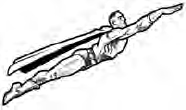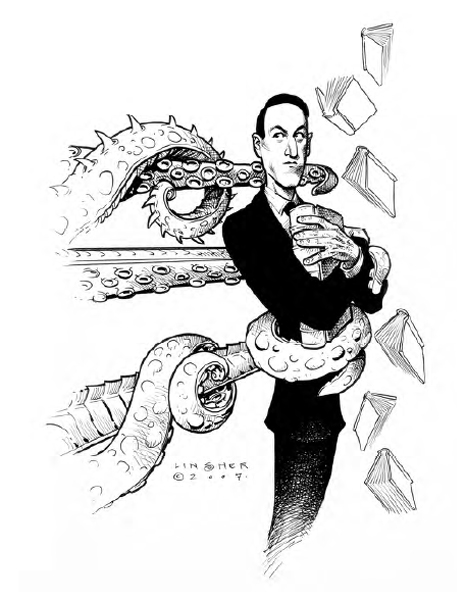Read Our Gods Wear Spandex Online
Authors: Chris Knowles
Our Gods Wear Spandex (13 page)

RACONTEURS
In their heyday, the pulps attracted a wide range of authors, with a wide range of talent and varying degrees of interest in the occult. Among them were luminaries like Edgar Rice Burroughs, fantasy giants like H. P. Lovecraft and Robert E. Howard, and serious occultists like Dion Fortune and Sax Rohmer. All of them contributed spiritually and materially to the coming comic craze by combining heroic fiction with themes taken from the ancient mysteries.
Edgar Rice Burroughs (1875–1950) is a pivotal figure in the development of the superhero. And although it is unclear what direct associations he may have had
with occult or esoteric groups, it is certain that his work is rife with mystical themes.
67
Scion of a middle-class Masonic family, Burroughs left home after high school to seek adventure. He worked on a cattle ranch, did a stint in the military, and held a series of menial jobs, until boredom and financial pressure finally inspired him to try his hand at writing. He sold his first story, “Under the Moons of Mars,” to
All-Story Magazine
in 1912.
Burroughs' Mars yarns are alternately known as the
John Carter, Warlord of Wars
series or, among hardcore fans, the
Barsoom
series. What is most remarkable about the stories is that Carter reaches the red planet, not by rocket, but by using the occult art of astral projection. He describes this mystical process: “I closed my eyes, stretched out my arms toward the god of my vocation and felt myself drawn with the suddenness of thought through the trackless immensity of space.”
68
Not only can Carter astrally project himself into space, he is also immortal. Because of the lighter gravity on Mars, he is a superman there, and becomes a warlord when he marries the Martian princess Dejah Thoris.
Fritz Leiber commented on the esoteric roots of Burroughs' space-faring hero, saying: “I got the impression that Edgar Rice Burroughs had found in Theosophy a rich source of background materials for his
Mars
books; his chief job seemed to have been adding canals and atmosphere plants.”
69
Leiber also notes other themes in the
Mars
stories that were initially popularized in Theosophist literature, including “instantaneous interplanetary travel by thought power; each planet having its characteristic ray … and airships held aloft by tanks of these rays; Methuselah-size lifetimes of one thousand years … creation of phantom and living matter by thought power … and finally the oppression and persecution of wise freethinkers by an evil priesthood.” Sword-and-sorcery legend L. Sprague De Camp added that” altogether life in the Theosophical Atlantis resembles nothing
so much as life on Mars as pictured in the Martian novels of Edgar Rice Bur-roughs.”
70
Burroughs himself claimed that all of the Martian races descended from the “Tree of Life,” a term borrowed from the Kabbalah.
Later in the same year that the
Mars
stories appeared, Burroughs turned the pulp world on its ear with the publication of his novella,
Tarzan of the Apes
. Tarzan was a huge hit and brought Burroughs all sorts of merchandizing opportunities. He formed his own company, and aggressively licensed his characters to radio, movies, comics, and all manner of enterprises. A pioneer of saturation marketing, he provided a model for later companies like Disney and DC Comics. As
The New York Times
noted “before Tarzan, nobody understood just how big, how ubiquitous, how marketable a star could be.”
71
Following the success of
Tarzan
and
John Carter
, Burroughs introduced the
Pellucidar
novels, starting with
At the Earth's Core
in 1922. In this tale, a group of scientists discover Pellucidar, a world inhabited by dinosaurs and—believe it or not—psychic pterodactyls inside the Earth's crust.
72
Burroughs even sends Tarzan to Pellucidar in 1930 in
Tarzan at the Earth's Core
. Later, he introduced the
Carson of Venus
books, starting with
The Pirates of Venus
, first serialized in
Argosy
in 1932. This series stars astronaut Carson Napier, who, like Carter, has occult powers—in this case, telepathy. All these psychic supermen seem to reflect Burroughs' straining toward a new race, one that is both physically powerful and morally upright, and possessed of extrasensory, occult powers that set them apart from the rest of humanity.
For some bizarre reason best left to sociologists, the Chinese became the favorite villains of the pulps. Baddies like Shu Ling, Yow Sum Gay, Wu Fang, and Chang Ch'ien regularly wrought havoc in magazines like
Dime Detective
and
Spicy Mystery
. The granddaddy of all Asian arch-villains, Fu Manchu, was created by Englishman Arthur Sarsfield Ward (1883–1959), writing as Sax Rohmer. Fu Manchu is an occult-oriented character whose existence Rohmer describes as a danger to the entire white race.
73
He heads a network of Chinese secret societies bent on destroying Western civilization. His nemesis, Sir Denis Nayland Smith, is a blatant Sherlock Holmes knockoff, complete with his own Watson, Dr. Petrie. However offensive their racist edge today, the
Fu Manchu
books were a huge hit in their time and inspired a horde of imitators, several film adaptations, a Republic Pictures serial, a radio program, a comic strip, and even a short-lived television serial. Rohmer was not some jingoistic, ethnocentric nativist, however. He was a worldly, erudite man completely immersed in the occult. Rising above humble beginnings, he developed an early interest in writing and in 1903, at the age of twenty, netted his first sale (“The Mysterious Mummy,”
Pearson's Magazine
). He took his pen name from the Old English
sax
, meaning “sword,” and
rohmer
, meaning “roamer.”
As a youth, Rohmer, like many of his time, had a deep-seated fascination with ancient Egypt. Indeed, Peter Haining records that Rohmer is “most clearly remembered for his knowledge of Egyptology and as a practitioner of its rites.”
74
Rohmer's introduction to the Egyptian rites came by way of his family doctor, Dr. R. Watson Councell, who reportedly initiated him into the Rosicrucian Society. In 1925, Rohmer wrote an introduction for Councell's book
Apologia Alchymiae
, reportedly the only introduction he ever wrote for another author's book.
Rohmer's involvement with the occult was extensive.
75
He joined the Golden Dawn and wrote occult-themed works, including stories like “Brood of the Witch Queen” (1918), “Grey Face” (1924), and “The Green Eyes of Bâst” (1920), and books like
The Romance of Sorcery
(1913). Through his work with the occult,
Rohmer came to believe that “a great new adept” was coming—one who would “pour the light of the East into the Darkness of the West.”
76
Of course, this fascination with superhuman powers brings us right back to the comic books. And it is through Marvel Comics that Rohmer's work was introduced to a new generation. In 1972, Marvel bought the rights to
Fu Manchu
and assigned two of its most mystically minded creators to update the property. Capitalizing on the Kung Fu craze inspired by Bruce Lee, Steve Englehart and Jim Starlin created “Shang Chi, the Master of Kung Fu” in 1973 (
Marvel Special Edition
#15). Shang Chi, the son of Fu Manchu, rebels against his father and joins the British Secret Service to combat the paternal villain's quest for world domination. The series, which greatly mitigates the racist tinge of Rohmer's original tales, was a big hit and ran for ten years. Shang Chi survives as a Marvel character, although the company gave up rights to the original Rohmer characters.
77
Sorcery was an ever-present theme in the pulps, but a new generation of writers would move beyond the usual witch-doctor/murderous cult riffs and make the occult the focus of their fiction. Coincidentally, the three leading lights of this movement—H.P. Lovecraft, Robert E. Howard, and Dion Fortune—would lead unhappy lives and die before their time. But their work would become the entry point for serious exploration of mystical themes in popular fiction.
No investigation of the occult roots of pulp fiction would be complete without some mention of Howard Phillips Lovecraft (1890–1937). Lovecraft had a knack for conveying pure, existential terror unmatched by any other writer in the genre. Born the last scion of an old aristocratic family, Lovecraft lived and worked in obscurity. Left penniless by a father driven mad by syphilis and a grandfather who squandered the family's fortune, he was haunted by images of decay and degeneracy throughout his life.
Lovecraft was a child prodigy who exhausted his grandfather's library at a very early age. He began to write—first, nonfiction articles for a variety of magazines,
and eventually stories for pulp magazines. His career in the pulps brought him into contact with writers like Clark Ashton Smith and Robert E. Howard, both of whom he kept as correspondents. He is most famous as a writer of horror stories for
Weird Tales
.

Lovecraft was heavily influenced by Edgar Allan Poe and an Anglo-Irish fantasy writer named Lord Dunsany. When it comes to pure imaginative power, however, Lovecraft has no match. He constructed a coherent, overarching “mythos” that runs throughout all of his (non-serial) stories, complete with a fictional satanic bible,
The Necromonicon
, that many readers believe to this day is a real book.
78
To enter Lovecraft's imaginative world is to enter a world of unending nightmare that is crystalline in its lucidity and luminous in its clarity.
Though Lovecraft insisted that he was a scientific rationalist, he constructed a complex cosmology of hideous extraterrestrial beings that once ruled the Earth. With the rise of man, these chimeras go into hiding, and begin preparing for the day when they will reemerge and take possession of the planet once more. Creatures with names like Chthulu and Nyarlathotep gather human acolytes to worship them as gods in rites replete with blasphemy and depravity. Lovecraft's descriptive powers are so effective that many readers seriously question his self-professed mechanistic atheism.
Many researchers have speculated that Lovecraft had extensive contacts with esoteric and occult organizations like the Theosophists or the OTO. Aleister Crowley's disciple Kenneth Grant, for instance, has written extensively on the parallels between Lovecraft's and Crowley's work.
79
Lovecraft has featured prominently in occult conspiracy theory, with some writers claiming that he was actually in contact with demonic spirits and wrote his numinous tales under their direction. Occultist Tracy Twyman maintains that Lovecraft's stories are adaptations of the stories of the so-called Nephilim, or fallen angels, from the ancient Book of Enoch.
80
And mercenary-turned-pulp writer E. Hoffman Price
introduced Lovecraft to several occult and Theosophical concepts during their extensive correspondence.
81
Lovecraft had a marked influence on the horror and sci-fi genres, and many popular writers have tried to replicate his Cthulu Mythos in their tales. He also had a strong influence on comics writers like Gardner Fox and Alan Moore. It's interesting to note that legendary DC Comics editor Julius Schwartz began his career as Lovecraft's literary agent.
Robert Ervin Howard (1906–1936) was born the only child of a Texas country doctor and a sickly mother. A voracious reader, he developed an early interest in boxing and weight lifting that found expression in his writing for the adventure pulps and boxing magazines. An early interest in ancient history led to a lasting fascination with barbarian tribes like the Picts of ancient Scotland. He was also a fan of occultic fiction of magazines like
Weird Tales
, and began a long-lasting correspondence with H. P. Lovecraft, joining what came to be known as The Love-craft Circle, a precursor of later sci-fi societies and organizations.

